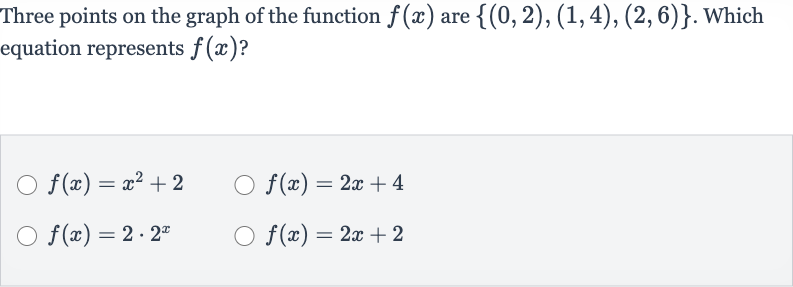Full solution
Q. Three points on the graph of the function are . Which equation represents ?
- Test Function : We will test each given function with the points provided to see which one matches all the points.First, let's test the point with each function.
- Test Function : Testing with :.This matches the point .
- Test Function : Testing with :This does not match the point . We can stop considering this function.
- Test Function : Testing with :
.
This does not match the point .
We can stop considering this function.Testing with :
.
This matches the point . - Test Function (,): Testing with :
.
This does not match the point .
We can stop considering this function.Testing with :
.
This matches the point .Testing with :
.
This matches the point . - Test Function (,): Testing with :
.
This does not match the point .
We can stop considering this function.Testing with :
.
This matches the point .Testing with :
.
This matches the point .Now let's test the point with the remaining functions that matched the first point. - Test Function (,): Testing with :
.
This does not match the point .
We can stop considering this function.Testing with :
.
This matches the point .Testing with :
.
This matches the point .Now let's test the point with the remaining functions that matched the first point.Testing with :
.
This does not match the point .
We can stop considering this function. - Test Function (,): Testing with :
.
This does not match the point .
We can stop considering this function.Testing with :
.
This matches the point .Testing with :
.
This matches the point .Now let's test the point with the remaining functions that matched the first point.Testing with :
.
This does not match the point .
We can stop considering this function.Testing with :
.
This matches the point . - Test Function (,): Testing with :
.
This does not match the point .
We can stop considering this function.Testing with :
.
This matches the point .Testing with :
.
This matches the point .Now let's test the point with the remaining functions that matched the first point.Testing with :
.
This does not match the point .
We can stop considering this function.Testing with :
.
This matches the point .Testing with :
.
This matches the point . - Test Function (,): Testing with :
.
This does not match the point .
We can stop considering this function.Testing with :
.
This matches the point .Testing with :
.
This matches the point .Now let's test the point with the remaining functions that matched the first point.Testing with :
.
This does not match the point .
We can stop considering this function.Testing with :
.
This matches the point .Testing with :
.
This matches the point .Finally, let's test the point with the remaining functions that matched the first two points. - Test Function (,): Testing with :
.
This does not match the point .
We can stop considering this function.Testing with :
.
This matches the point .Testing with :
.
This matches the point .Now let's test the point with the remaining functions that matched the first point.Testing with :
.
This does not match the point .
We can stop considering this function.Testing with :
.
This matches the point .Testing with :
.
This matches the point .Finally, let's test the point with the remaining functions that matched the first two points.Testing with :
.
This does not match the point .
We can stop considering this function. - Test Function (,): Testing with :
.
This does not match the point .
We can stop considering this function.Testing with :
.
This matches the point .Testing with :
.
This matches the point .Now let's test the point with the remaining functions that matched the first point.Testing with :
.
This does not match the point .
We can stop considering this function.Testing with :
.
This matches the point .Testing with :
.
This matches the point .Finally, let's test the point with the remaining functions that matched the first two points.Testing with :
.
This does not match the point .
We can stop considering this function.Testing with :
.
This matches the point . - Test Function (,): Testing with :
.
This does not match the point .
We can stop considering this function.
Testing with :
.
This matches the point .
Testing with :
.
This matches the point .
Now let's test the point with the remaining functions that matched the first point.
Testing with :
.
This does not match the point .
We can stop considering this function.
Testing with :
.
This matches the point .
Testing with :
.
This matches the point .
Finally, let's test the point with the remaining functions that matched the first two points.
Testing with :
.
This does not match the point .
We can stop considering this function.
Testing with :
.
This matches the point .
Since the function is the only function that matches all three points, this is the equation that represents .
More problems from Compare linear and exponential growth
QuestionGet tutor help
QuestionGet tutor help
QuestionGet tutor help
QuestionGet tutor help
QuestionGet tutor help
QuestionGet tutor help
QuestionGet tutor help

